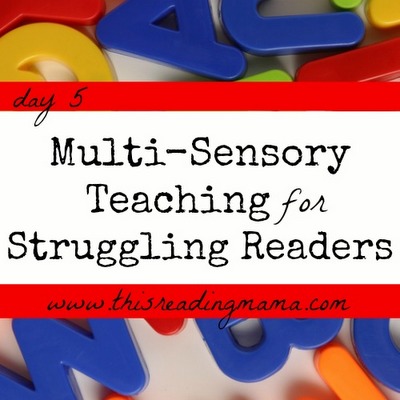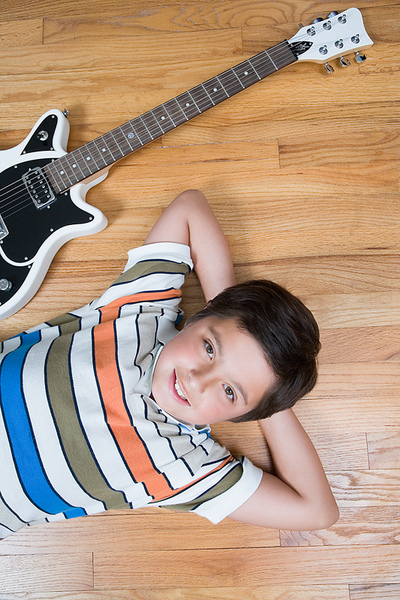This post may contain affiliate links. Please read my full disclosure policy.
Welcome back to day 5 of Multi-Sensory Activities for Teaching Reading; just one of the 5-day series from the bloggers at iHomeschool Network! If you’re joining me for the first time today, please click on the image above or here to see what’s been going on this week. Today, we’re going to break it down a little further as we talk about the multi-sensory approach for teaching reading.
My Biggest Tip for Struggling Readers
While I don’t currently have a struggling reader at home, I have taught plenty in the classroom setting and as a reading tutor. I get lots of email asking me how people can help their struggling readers. Probably my biggest tip is to make sure what you’re asking your child to do is at her developmental level.
It doesn’t matter how many ways you try to integrate the five senses into teaching sight words or how “fun” you make it. If the child doesn’t know his letters and most sounds, he’s not going to be able to truly learn sight words, especially five new sight words a week! He has no foundation to attach the words to. You are teaching at his frustration level. Very little {if any} learning happens at this level.
Now, I’m not a math person. But if you are, maybe this analogy will work. 😉 I can’t expect a child who doesn’t know addition to be able to understand multiplication. He can memorize his multiplication facts, but memorization will only be the band aid covering up the gaping hole in his understanding of how numbers work. He simply doesn’t have the foundation to apply it, critique it, manipulate it or make it his own.
It’s the same with struggling readers. If the foundation isn’t there, new information will only crack {at best}.
If your struggling reader is in school, be your child’s advocate. So what if the teacher {and you} need to go back to the basics of literacy? Do it! Don’t accept the faster-paced curriculum just because it’s what the grade level is teaching.
Same with homeschooling moms. Just because Suzy’s 2nd grader is reading that text or learning that phonics pattern doesn’t mean your child needs to. And just because your curriculum tells you to do it doesn’t mean it will be developmentally appropriate for your child.
To read a little more about this, please visit my guest post over at 1+1+1=1.
Using the Multi-Sensory Approach for Teaching Struggling Readers
Now for the meat and ‘taters! I am so excited to have a couple of testimonials today from mamas who have struggling readers they are teaching at home. I’m honored to have Jennifer A. Janes and Marianne Sunderland. Listen and be encouraged by their stories.
My Journey to Teaching Reading Using Multi-Sensory Methods
When I began homeschooling six years ago, I was pretty sure I could handle it. I had been a classroom teacher, after all. I was right. It took me a little time to relax and realize that I didn’t have to do everything like I had in public school, but the curriculum I had bought for my older daughter worked beautifully. She learned to read pretty easily, and I felt quite smug in my accomplishments.
And then, two years later, her little sister started kindergarten. This was my baby, and I knew how smart she is, so I didn’t anticipate any problems. Except the curriculum her sister had excelled in wasn’t working. I tried another reading program, and another. By Thanksgiving, it was clear that traditional reading programs weren’t going to work for her. Something was terribly wrong—with those programs. They didn’t meet her needs. While she is what the education community would call “learning disabled,” I was certain that she could learn, if I could figure out how to teach her. I was right.
After a lot of trial and error and consulting with some wonderful people who have helped me on this journey, I learned that my daughter learns best using multisensory methods. I never realized that this was possible to do with reading because I’m more of a “traditional” learner, with auditory and visual strengths. So is my older daughter. And that’s how I taught as a classroom teacher. But when I got out of my box and started researching multisensory methods for teaching reading, I realized just how many there are!
My most recent discovery is The Struggling Reader products, which are some of the most fun multisensory reading activities I’ve come across. (Bill and Kristen Eckenwiler sponsored my trip to Teach Them Diligently in Nashville a few weeks ago. I got to spend time with them and love their hearts and their expertise!) Both of my girls (even the one who doesn’t need the extra help) enjoy the activities and look forward to our “skills practice” times. I enjoy the fact that my daughter is making progress in reading and is enjoying the process!
If you want more information about my journey homeschooling a child with special needs and teaching with multisensory methods, please visit my Multisensory Homeschool for Children with Special Needs series and other posts on my blog.
Jennifer Janes lives in Arkansas with her husband, two daughters, and two cats. She is a former classroom teacher turned homeschooling mom of one neurotypical child and one with medical and neurodevelopmental needs as well as learning challenges. She shares the adventure on her blog, Facebook, and Twitter.
* * *
Dyslexia and Multi-Sensory Teaching
Dyslexia is a language-based learning difference that causes otherwise bright children and adults (it is never outgrown) to struggle with the written word – including reading, writing and spelling. Approximately 20% of the population struggle with the genetically-based phenomenon.
Fast forward a few more years and several more children, all with dyslexia. Since we were homeschooling, the responsibility fell to me to figure out how best to teach them. I am so thankful for the researchers at Yale University and others who have dedicated their time and talents to figuring out the brilliant, yet seemingly flawed, dyslexic mind.
Not surprisingly then, researchers have found that right-brain dominant learners learn better when teachers tap into their right-brain strengths such as by using music, color, and hands on experiences – in other words, multi-sensory learning.
Last year we homeschooled our 7th child for his Kindergarten year using all multi-sensory methods and the results have been nothing short of amazing! You would never know that he is dyslexic even though he has all of the classic signs of dyslexia in a younger child.
If you would like more information on dyslexia or think that someone you know may have dyslexia, you may be interested in my book, Dyslexia 101, available for pdf download and on Amazon Kindle Reader.
 Marianne Sunderland is a homeschooling mother of eight lively children ages 2 to 21, including adventurous and homeschooled sailors, Zac and Abby Sunderland, known for their world-record setting around the world sailing campaigns. Marianne is passionate about encouraging families to discover and nurture their children’s God-given gifts and talents, in and outside of the classroom. Her varied experiences homeschooling through difficult times and with kids who learn differently has taught her much about stepping outside the box in her own homeschool. Marianne’s blog, Abundant Life, provides weekly articles on faith, family and homeschooling that will bless and encourage you: Homeschooling with Dyslexia.
Marianne Sunderland is a homeschooling mother of eight lively children ages 2 to 21, including adventurous and homeschooled sailors, Zac and Abby Sunderland, known for their world-record setting around the world sailing campaigns. Marianne is passionate about encouraging families to discover and nurture their children’s God-given gifts and talents, in and outside of the classroom. Her varied experiences homeschooling through difficult times and with kids who learn differently has taught her much about stepping outside the box in her own homeschool. Marianne’s blog, Abundant Life, provides weekly articles on faith, family and homeschooling that will bless and encourage you: Homeschooling with Dyslexia.
Enjoy teaching!
~Becky




This has been a very helpful series. I have pinned these and doubtless, will be using the ideas over the next few weeks.